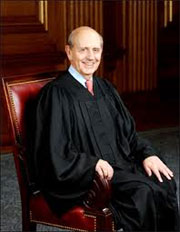Supremely Slanted
Table of Contents:
Stephen Breyer
 The paper's flimsy coverage of Ginsburg was followed a year later by even slimmer coverage of Clinton's next nominee, Stephen Breyer, the subject of a mere 20 stories. Breyer had been in the running for the court before but had not hit it off with Clinton at their first meeting. But he made the cut the second time around, upon the retirement of Justice Harry Blackmun.
The paper's flimsy coverage of Ginsburg was followed a year later by even slimmer coverage of Clinton's next nominee, Stephen Breyer, the subject of a mere 20 stories. Breyer had been in the running for the court before but had not hit it off with Clinton at their first meeting. But he made the cut the second time around, upon the retirement of Justice Harry Blackmun.
The Times editorial page (under future Executive Editor/ogre-in-chief Howell Raines) was surprisingly tough on Breyer. An editorial on July 26 advised against his nomination based on Breyer's failure of recusal in a controversy involving Breyer's personal wealth and his investment in an insurance syndicate with Lloyd's of London.
Although Breyer suffered some bumps on the editorial page, Times news reporters cleared a smooth path. The coverage was dutiful, sparse, and designed not to raise ideological hackles. Breyer was labeled a liberal precisely once, by Linda Greenhouse, and even that reference was tempered: “Own political leanings are quite liberal, nonetheless reject the classic liberal constitutional view...”
The initial profile of the nominee from David Margolick on May 14, 1994, under the headline “Scholarly Consensus Builder,” included an even more flattering subhead: “Raw Brain Power.” Margolick emphasized “The labels most often used to describe him are “centrist” and “technocrat.” While noting “There are those who find him snippy and snooty, caustic or condescending,” Margolick balanced that criticism with flattery: “Judge Breyer is a man of great range.”
A compare-and-contrast exercise by Linda Greenhouse on May 22, 1994, seemed designed to make Clinton's two nominees look superior to Bush pick Clarence Thomas. She noted Breyer's nomination “appears to be a waltz to near-unanimous confirmation,” especially after the trouble caused by the Thomas nomination, specifically Bush's claim that Thomas was the most qualified for the job. In Greenhouse's telling, such hyperbole caused “deep cynicism” that was only healed somewhat by Ginsburg's “tranquil 96-3 confirmation.”
The Times occasionally jabbed Breyer from the left, relaying in a July 12, 1994 story liberal Sen. Howard Metzenbaum's allegations about Breyer's alleged conflict of interest in refusing to recuse himself from pollution cases that might have indirectly affected his investment in a Lloyd's of London insurance syndicate. (The Times editorial against Breyer on the matter appeared two weeks later.)
Still, Greenhouse showed her confidence on July 13: “There is no doubt that Judge Breyer will be confirmed as a Supreme Court Justice...” The next day, under the headline “Portrait of a Pragmatist; Confirmation Hearing for Breyer Elicits His Emphasis on Rulings' Lasting Effects,” she described Breyer as “a judge of moderate leanings, a self-described pragmatist.” Greenhouse was also responsible for the paper's single admission of Breyer's liberal views, July 17: “Both Justice Ginsburg and Judge Breyer are highly respected judges who, while their own political leanings are quite liberal, nonetheless reject the classic liberal constitutional view...” In contrast, Clarence Thomas was bluntly termed “a committed conservative.”
(It's a demonstration of the sharpness of the paper's long-term liberal slant that veteran Supreme Court reporter Linda Greenhouse, who marched for Roe v. Wade and made a commencement speech at Harvard in 2006 lamenting “the sustained assault on women’s reproductive freedom and the hijacking of public policy by religious fundamentalism,” actually comes off as one of the paper's more balanced reporters.)


